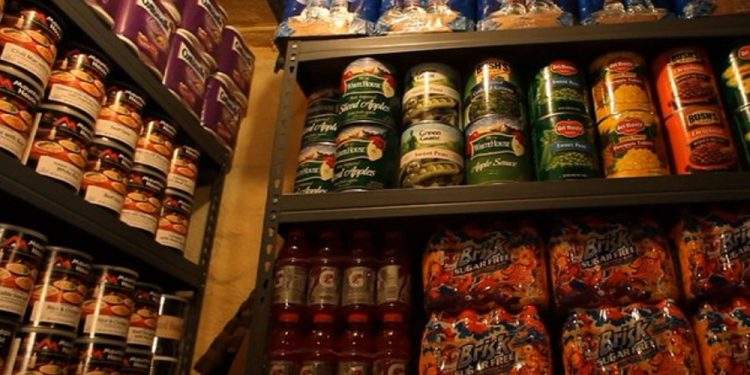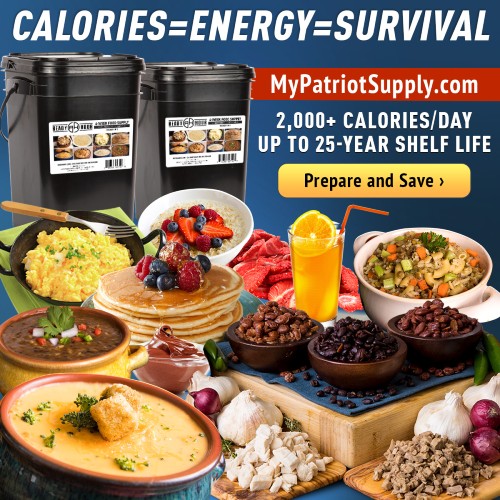- Watch The JD Rucker Show every day to be truly informed.
Editor’s Note: We do everything we can to filter through the various opinions when it comes to prepping. There is no universally agreed upon strategy. Everyone must assess their own situation and come up with a plan. All we can do is offer some guidance.
For today’s (long overdue) episode of Late Prepper, I referenced the article below by Kevin Hughes at Natural News. As I noted in the show, I don’t completely agree with everything that’s in the article but it’s a good starting point, especially for those who are truly late to the game. Here’s my show followed by Kevin’s article…
Stockpiling foods that can last for weeks or years is not just a smart way of beating rising food costs. It can also help you save money and be prepared for emergencies.
In the event of a long power outage, having even a small supply of long-shelf life foods, such as dry goods, canned goods and freeze-dried foods, can make a big difference. You’ll also be grateful to have a little extra food at home when you get sick and can’t go out to buy groceries. Because of inflation and rising food prices, keeping shelf-stable foods is a good investment.
Tips for stocking up on food
Remember to stock up on foods that you actually eat or drink. Don’t stockpile foods that you or your family members are allergic to or won’t touch.
When buying groceries, you should also know the exact quantity of food your family consumes on a regular basis; buy some extra. (Related: 10 Tips for stockpiling food.)
Foods from a supermarket or grocery all have an expiration date, which indicates when a food product will start to taste bad. However, some food products are still safe to eat well past their expiration date.
To determine if you should get rid of an expired food item or not, look for signs that the food has gone bad. Bloated or leaking cans, signs of mold or insect damage and a foul odor are just some warning signs that a product is no longer safe for consumption.
You should also stock up on ingredients that you often use in your recipes, like herbs and spices and canned sauces. If your family likes to drink tea or coffee, stock up on them as well.
Pay attention to the foods you want to stockpile and learn to experiment in the kitchen. Before buying plenty, try cooking with a certain food or product to make sure that you really like its taste and you’ll consume it.
Dry goods like salt, sugar, grains, flour, rice and dried beans can be stored at room temperature. Remember that dry goods are historically crucial food supplies that you need to store in bulk for months or years. To prolong their shelf life, you can store them in Mylar bags or other airtight containers.
Ways to extend the shelf life of foods
There are many ways to extend the shelf life of foods in your stockpile. Here are some tips to follow:
- Store food in a cool, dry place. Be mindful of the temperature; some foods are fine with room temperature while others prefer freezing temperatures.
- Check the humidity in your storage area. Wheat, flour and other dry goods should be stored in a place with little to no moisture in the air. Fresh foods like fruits and vegetables require a specific humidity level to extend the time they can be in storage.
- Fats react with oxygen and easily go rancid, so choose foods with low fat content. These foods will keep for long in storage.
- Consider reducing oxygen in your storage area since oxidation causes food to spoil quickly.
- Use tightly sealed containers to reduce oxidation and make food last longer.
- Store foods away from direct sunlight and in airtight containers.
Foods with a long shelf life
When SHTF, having a stockpile of shelf-stable foods will help you and your family survive.
Here’s a list of the best long-shelf life foods to store:
- Foods that last 25 to 30+ years: White rice, wild rice, rolled oats, corn, buckwheat and red or white winter wheat; legumes like pinto beans, black beans, lentils and peas; waxed cheese; dehydrated fruit slices; freeze-dried eggs and instant coffee; white flour; dried corn like dent or flint corn; hardtack; soy sauce; and freeze-dried meals like MREs (meals ready to eat)
- Foods that last 5 to 25 years: Raw molasses, powdered eggs, dehydrated carrots, ghee, powdered low-fat milk, powdered sour cream, canned goods, freeze -dried bacon and freeze-dried fruits
- Foods that last 2 to 5 years: Virgin coconut oil, spices, mustard powder, dark chocolate, cocoa powder, pasta products, canned soup and chili, canned tuna, chicken and beef; pemmican, frozen eggs, jelly, jam, canned fruit, pickled veggies, peppercorns and flavored liquor
- Foods that last 1 to 2 years: Regular beef jerky, bouillon cubes, canned tomato sauce, salsa and other tomato-based products; vegetable oil, whole powdered milk, peanut butter, dried raisins, cranberries and cherries; homegrown garlic, pancake mix, ground pepper, frozen broccoli, corn off the cob and vacuum-sealed frozen meat
- Foods that last 3 to 9 months: Hard winter squash, long storage apples, long storage potatoes, brown rice, short storage potatoes, breakfast cereal, block cheese, farm-fresh (unwashed) eggs, granola bars, homegrown carrots or parsnips, supermarket garlic cloves, vanilla beans, storage onion, sausage, beer and packaged frozen meat
- Foods that last a couple of weeks to three months: Sweet onions, minced jarred garlic, pears, short storage apples, supermarket eggs, regular squash, strawberries, walnuts, garden tomatoes, pumpkin, supermarket tomatoes and asparagus
- Foods that last indefinitely: Salt, sugar, baking soda and baking powder, if stored properly
- Raw honey, a healthy sugar substitute, can last forever.
Visit FoodFreedom.news for more articles like this.
Watch the video below to learn how to make your own storable food with a long shelf life.
This video is from the Health Ranger Report channel on Brighteon.com.
More related stories:
- Food storage tips and tricks for preppers.
- Food storage tips: 11 Superfoods that boost your nutrient intake.
- Prepping on a budget: 12 Ways to prep without spending too much.
- Food storage tips: How to keep pests out of your survival stockpile.
Sources include:
- Preserve your retirement with physical precious metals. Receive your free gold guide from Genesis Precious Metals to learn how.
Controlling Protein Is One of the Globalists’ Primary Goals
Between the globalists, corporate interests, and our own government, the food supply is being targeted from multiple angles. It isn’t just silly regulations and misguided subsidies driving natural foods away. Bird flu, sabotaged food processing plants, mysterious deaths of entire cattle herds, arson attacks, and an incessant push to make climate change the primary consideration for all things are combining for a perfect storm to exacerbate the ongoing food crisis.
The primary target is protein. Specifically, they’re going after beef as the environmental boogeyman. They want us eating vegetable-based proteins, lab-grown meat, or even bugs instead of anything that walked the pastures of America. This is why we launched a long-term storage prepper beef company that provides high-quality food that’s shelf-stable for up to 25-years.
At Prepper All-Naturals, we believe Americans should be eating real food today and into the future regardless of what the powers-that-be demand of us. We will never use lab-grown beef. We will never allow our cattle to be injected with mRNA vaccines. We will never bow to the draconian diktats of the climate change cult.
Visit Prepper All-Naturals and use promo code “veterans25” to get 25% off plus free shipping on Ribeye, NY Strip, Tenderloin, and other high-quality cuts of beef. It’s cooked sous vide, then freeze dried and packaged with no other ingredients, just beef. Stock up for the long haul today.









Thanks for this article, JD. It’s imperative that folks begin preparing for what is coming. It’s coming and it will be deadly for the unprepared. Initially, it will begin with spot shortages and shortages push prices even higher. But it will get much worse. The Bible confirms this in Revelation chapter 6 – verses 5-6. It will eventually take a full day’s wage just to eat that day. Nothing left for non-food expenses. Expect to see conditions worsening over the coming months and into 2023 and beyond.
It would also be wise to prepare in other ways. Alternate forms of producing heat. Water sources and the ability to filter. A supply of medicine. Extra daily necessities – such as soap, toothpaste, etc.